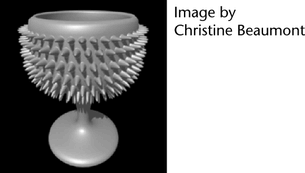
Displacement maps are grayscale textures you map to objects to create true surface relief (elevations and depressions) on an otherwise flat object.
With Displacement maps, depressions and elevations become part of the geometry of the object, changing the topology, unlike Bump maps that only create the illusion of surface relief.
Displacement maps move an object’s vertices. By default, the height of the displacement is determined by the Alpha Gain value in the displacement map’s Attribute Editor. If you turn on Alpha is Luminance, the height result is based on the intensity of the pixels instead.
Use displacement maps to create shallow or deep surface relief. For example, you can create embossing, mountain peaks and valleys, spikes, and so on.
Because Displacement maps create true surface relief, they:
You can connect a texture as a displacement map by connecting it to the Displacement mat attribute in the material’s shading group. See Connect a texture as a displacement map for more information.
Because displacement mapping changes the volume of an object, it’s bounding box may become too small or too large.
Bounding boxes, which represent the bounding volume of an object, can be used to speed up Maya operations and can make a significant difference for complex models.
 Except where otherwise noted, this work is licensed under a Creative Commons Attribution-NonCommercial-ShareAlike 3.0 Unported License
Except where otherwise noted, this work is licensed under a Creative Commons Attribution-NonCommercial-ShareAlike 3.0 Unported License